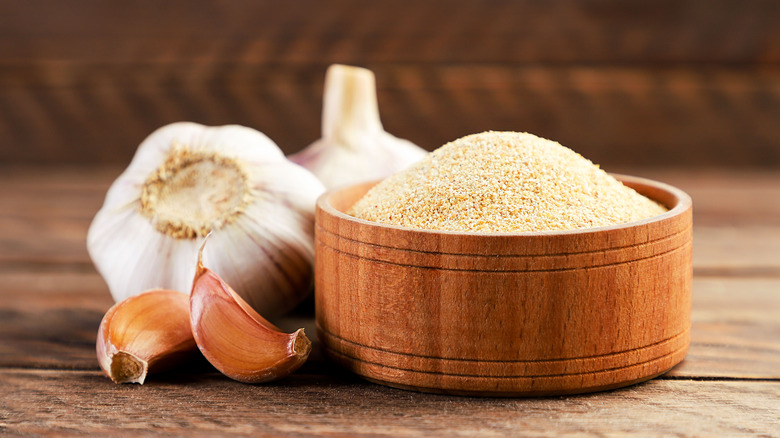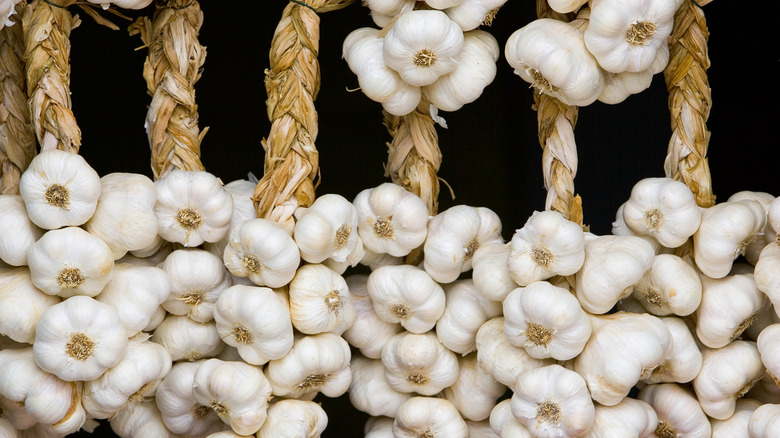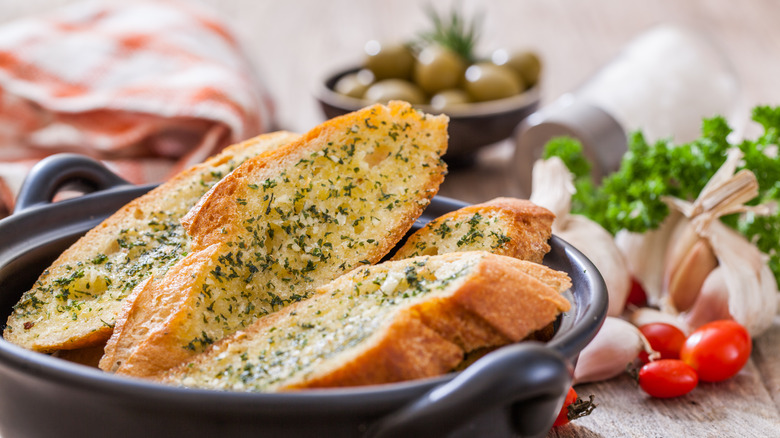The Biggest Mistake You Could Be Making With Garlic Powder
Chances are you've heard the saying, "There's no such thing as too much garlic." Not everyone feels that way, but based on the roughly 28 million metric tonnes of garlic produced worldwide in 2020, many people do. From whole fresh cloves to minced, granulated, flakes, powdered, oil, garlic salt, and even black fermented garlic, there are plenty of ways to incorporate this healthy Allium sativum plant into your daily cooking routine. By far, the easiest is powdered garlic — but are you using it correctly?
The biggest mistake you could be making with garlic powder involves hydration, and the solution is a very easy fix. By the time garlic exists in a powdered form, it has gone through a dehydration process in which the two primary flavor compounds in garlic, alliin and alliinase, have essentially been deactivated. The taste-producing compounds are still there, just in a neutralized state, resulting in flavor reduction if you sprinkle the powder onto your food as is, straight from the jar.
Fortunately, all you need to do is "wake it up." How the two compounds interact with each other is very scientific, but the solution requires nothing but a simple liquid from Mother Nature: H2O, aka ordinary water.
How to rehydrate powdered garlic for flavor bounce-back
One extra step when using garlic powder in your recipe is well worth the minimal effort. Compared to reaching for fresh garlic cloves, the powdered version saves time, lasts much longer in your pantry, and provides a deep infusion of garlic flavor for any type of food. It also bypasses the pungent aftermath of "garlic fingers" from peeling and chopping fresh garlic. But to get all those benefits in a readily available form, you need to rehydrate the garlic powder.
To do that, measure the amount of powdered garlic you need for the recipe, and match it with the same amount of water. Mixing the powder and water reactivates those two dormant compounds to produce the complex, nuanced garlic flavor you're seeking. In particular, the water activates the alliinase compounds, consequently waking the allicin — and voila! You're ready to go. Avoid heating the mixture, then use it in your recipe as usual.
Garlic powder is there whenever you need it and can last in your pantry for up to three years. On the other hand, whole fresh garlic bulbs are usually good for three to six months when correctly stored, sans heat or humidity, or only about three weeks if separated into individual cloves. Either way, the paper-like shells on each clove must remain in place.
Cooking with powdered garlic
Cooking with powdered garlic is easy as long you don't overuse it. Remember that it's a highly concentrated version of the fresh cloves from which the powder originated. It's been ground into a fine powder for easy addition to your meals — but a little bit goes a long way.
When using this garlic version in recipes, ensure you have an actual garlic powder. Some so-called powders sold in supermarkets lean more toward a sand or granulated sugar consistency, while a true garlic powder will be ground ultra-fine, similar to pillowy cake flour. The difference could leave you with either an over- or under-garlic potency. Regardless, remember to rehydrate the powder first! Otherwise, you'll miss the well-rounded, deep garlic flavor that brings your dish to life.
Though some chefs make garlic-laden favorites such as garlic bread with minced fresh cloves, your available time (or youngster taste buds) often dictate the powdered version. That doesn't mean tasty flavor and texture are left by the wayside. For garlic-bread recipes requiring fresh garlic, substitute a one-eighth teaspoon of fine-powdered garlic for one standard-sized fresh clove.



